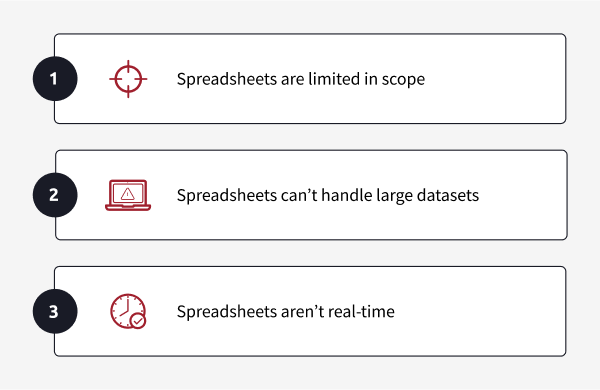
By: John Maher | March 13, 2025 | 5 min read
Advanced Planning and Scheduling (APS) software can dramatically simplify daily life for production planners and schedulers tasked with creating and optimizing production plans. However, the benefits of optimized production extend far beyond the role of production planning and scheduling. With the right tools, an advanced planning system can positively impact every corner of your enterprise, reshaping how teams collaborate, strategize, and operate.
How APS Drives Enterprise-Wide Performance Improvement
As manufacturing employees from the C-Suite to parts pickers can attest, an immense amount of time is often wasted by manual processes and tasks: checking factory capacity, quoting customer delivery, tracking order status, (re)prioritizing orders, expediting materials and orders, (re)promising delivery dates, and so on. Much of this wasted time is caused by factors such as:
- Production plans that aren’t aligned to demand
- Manual processes that can’t keep up with the business
- Inaccurate or out-of-date information
- Lack of visibility into production plans
- Miscues between departments
Implementing APS can address each of these challenges and more, allowing benefits to be realized almost immediately at every level of the organization.

Supply Chain/Procurement
An essential partner in production execution, it’s no surprise that this department has a lot to gain from an APS implementation. Procurement is responsible for getting the parts and raw materials to ensure the production plan can be carried out. Of course, they also need to better understand what will be required and by when so inventory levels and costs can be kept in check. APS systems support their efforts in several ways:
- Synchronizing procurement with the actual, capacity-constrained production scheduling aligns material replenishment with scheduled usage, helping to keep inventory levels low.
- Procurement has visibility into prioritized item shortages, making it easier for them to adapt to changes in production schedules and effectively expedite orders as necessary.
- Soft pegging of purchase orders to shortages allows procurement to quickly identify the demand(s) driving the shortages and the purchase orders necessary to supply them.
- Capable-to-promise dates (CTPD) are fully vetted for capacity and materials. This prevents unrealistic promises from being made that put pressure on procurement and add unnecessary costs.
- Expedite and slide signals are tied directly to the finite production schedule, so procurement is automatically notified.

Sales
To drive customer satisfaction, sales and production must work together. Unfortunately, that relationship is often strained due to lack of visibility into production capacity and status. Sales has a lot to gain from an APS implementation, including:
- CPTD are based on real-time production capacity and material availability. This allows sales to immediately provide reliable delivery date commitments, making sales cycles shorter and more efficient.
- CPTD are kept in alignment with current manufacturing resources, and sales is notified should an order begin to slip.
- Real-time, self-serve order status visibility vastly reduces the number of emails, phone calls, and chats with production control, making everyone more efficient and effective.
- Increased visibility and ability to meet delivery commitments builds customer trust and satisfaction.
- When material or capacity contention exists between two or more orders, visibility into constraints turns decision-making into a strategic rather than tactical approach and helps align decisions to corporate objectives.

Production Operations
Employee turnover is costly, so a manufacturing environment that functions like a well-oiled machine is an excellent employee retention asset. Here are a few ways those on the factory floor benefit from APS:
- A real-time priority (dispatch) list keeps the shop floor in perfect alignment with the current schedule.
- Expedite signals are automated, limiting the need for expediters because the operators already know when a job should be expedited.
- Production workers have upstream visibility, so they know when work will arrive.
- They also have visibility into work in the queue and ready to process. There is no need to guess what to work on next!
- Implementing an APS system drives documentation, e.g., production processes, primary and alternate resources, and estimated run and setup times. This documentation drives agreement, aids in process optimization and improvement, and shortens learning cycles for new employees.

Production Control
Production control managers play a pivotal role in ensuring manufacturing operations are carried out efficiently, on time, and within budget. APS software helps them by:
- Prioritizing the preparation of production documentation (drawings, work orders, quality plans, etc.) based on the finite production schedule.
- Providing a gating schedule to plan and execute gating/release of work to the shop floor based on the production pull.

Engineering
Engineering often gets overlooked when discussing APS benefits, but for Engineer-to-Order environments or highly engineered products, APS drives real benefits for this group as well.
- Less time is wasted because production support activities are tied directly to the finite production schedule, ensuring they are properly prioritized and timed.
- Engineers have visibility into the status of items, so they know which items are impacted by engineering changes and they don’t waste time making unneeded changes to obsolete items.

Quality Control
A critical component of the production workflow for complex manufacturing, APS benefits for the QC/QA department include:
- The ability to link non-conformances to work for visibility, prioritization, and schedule impact.
- Prioritization of incoming inspection work ensures urgent items are identified and addressed first.

Executive Leadership
With real-time visibility across the entire enterprise, executives can make more informed strategy decisions and ensure support for business objectives. For example:
- APS provides insights into enterprise capabilities and future business projects, giving executives the information to make key decisions on where to invest to ensure they can meet present and future demand.
- Prioritization rules that support the strategic goals of the enterprise can be embedded into APS workflows.
- APS provides tools to direct continuous improvement activities that will yield the highest benefits to the organization.

Information Technology (IT)
Last but not least, APS benefits the IT department, which is often tasked with implementing and supporting operational technologies.
- APS allows IT to leverage investments in existing IT solutions, such as ERP.
- APS provides additional capabilities that deliver hard returns for manufacturing and supply chain operations.
- Once implemented, APS requires little IT intervention beyond general server maintenance.
Explore the Benefits of Better Prioritization
Prioritization is a critical manufacturing operational strategy. When production plans are properly prioritized, this results in the ripple benefits we’ve talked about in this post. In an upcoming post, we’ll dig deeper into how APS helps focus the enterprise on critical priorities to keep everyone on track.
In the meantime, we invite you to learn more about how APS can help your business by reaching out to us. We’re happy to answer your questions. If you’d like to see APS in action, we can set up a demonstration of SyncManufacturing®, our patented planning and scheduling tools that can help you tackle even the most unique, complex production processes with clarity, control, and confidence.








